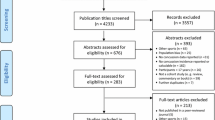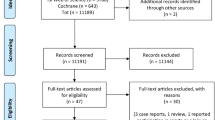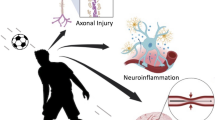Abstract
Background
Professional athletes seem to have a lower overall mortality risk than the general population, but controversy exists about whether athletes in sports associated with repetitive head impacts have a higher risk of mortality from neurodegenerative diseases.
Objective
We aimed to determine the risk of mortality from neurodegenerative diseases in sports associated with repeated head impacts compared with the general population or compared with athletes with no such exposure.
Methods
We conducted a systematic review with meta-analysis, systematically searching PubMed, Web of Science, Scopus, and SPORTDiscus (since inception to 14 May 2021) for studies comparing the risk of death from neurodegenerative disease in athletes participating in contact sports in which their heads recurrently receive blows from the bodies of other participants or from a ball versus a control group or dataset representing the general population.
Results
Six moderate- to high-quality retrospective studies including data from 41,699 athletes participating in contact sports (boxing, basketball, ice hockey, American Football and soccer) met all inclusion criteria to be included in the systematic review. Of these, three studies (N = 37,065 male professional soccer players) could be meta-analysed. Despite no differences in the risk of all-cause (p = 0.138), cardiovascular (p = 0.085) and cancer-related mortality (p = 0.136), soccer players presented with a significantly higher mortality risk from motor neuron disease (standard mortality rate 8.43; 95% confidence interval 3.07–23.13; p < 0.001).
Conclusions
Although more research is needed (particularly in other contact sports and with neurodegenerative disease as the cause of death), preliminary evidence suggests that participation in professional soccer might increase the risk of mortality from motor neuron disease compared with the general population. The present findings highlight the need for the design of preventive measures and for adequate neuropsychological monitoring in these athletes.
PROSPERO registration
CRD42020195647.




Similar content being viewed by others
References
Garatachea N, Santos-Lozano A, Sanchis-Gomar F, Fiuza-Luces C, Pareja-Galeano H, Emanuele E, et al. Elite athletes live longer than the general population: a meta-analysis. Mayo Clin Proc. 2014;89(9):1195–200.
Antero J, Tanaka H, De Larochelambert Q, Pohar-Perme M, Toussaint JF. Female and male US Olympic athletes live 5 years longer than their general population counterparts: a study of 8124 former US Olympians. Br J Sports Med. 2020;55:206–12.
Santos-Lozano A, Pareja-Galeano H, Sanchis-Gomar F, Quindós-Rubial M, Fiuza-Luces C, Cristi-Montero C, et al. Physical activity and Alzheimer disease: a protective association. Mayo Clin Proc. 2016;91(8):999–1020.
Mez J, Daneshvar DH, Kiernan PT, Abdolmohammadi B, Alvarez VE, Huber BR, et al. Clinicopathological evaluation of chronic traumatic encephalopathy in players of American Football. JAMA. 2017;318(4):360–70.
Kmush BL, Mackowski M, Ehrlich J, Walia B, Owora A, Sanders S. Association of professional football cumulative head impact index scores with all-cause mortality among National Football League players. JAMA Netw Open. 2020;3(5):e204442.
Manley G, Gardner AJ, Schneider KJ, Guskiewicz KM, Bailes J, Cantu RC, et al. A systematic review of potential long-term effects of sport-related concussion. Br J Sports Med. 2017;51(12):969–77.
Moher D, Liberati A, Tetzlaff J, Altman DG, Group P. Preferred reporting items for systematic reviews and meta-analyses: the PRISMA statement. J Clin Epidemiol. 2009;62(10):1006–12.
Stroup DF, Berlin JA, Morton SC, Olkin I, Williamson GD, Rennie D, et al. Meta-analysis of observational studies in epidemiology: a proposal for reporting. Meta-analysis Of Observational Studies in Epidemiology (MOOSE) group. JAMA. 2000;283(15):2008–12.
Kettunen JA, Kujala UM, Kaprio J, Bäckmand H, Peltonen M, Eriksson JG, et al. All-cause and disease-specific mortality among male, former elite athletes: an average 50-year follow-up. Br J Sports Med. 2015;49(13):893–7.
Taioli E. All causes of mortality in male professional soccer players. Eur J Public Health. 2007;17(6):600–4.
Wells GA, Shea B, O’Connell D, et al. The Newcastle-Ottawa Scale (NOS) for assessing the quality of nonrandomised studies in meta-analyses [cited 2021 May 15]. Available from: http://www.ohri.ca/programs/clinical_epidemiology/oxford.asp.
IntHout J, Ioannidis JP, Borm GF. The Hartung-Knapp-Sidik-Jonkman method for random effects meta-analysis is straightforward and considerably outperforms the standard DerSimonian–Laird method. BMC Med Res Methodol. 2014;14:25.
Bax L, Yu LM, Ikeda N, Tsuruta H, Moons KG. Development and validation of MIX: comprehensive free software for meta-analysis of causal research data. BMC Med Res Methodol. 2006;6:50.
Belli S, Vanacore N. Proportionate mortality of Italian soccer players: is amyotrophic lateral sclerosis an occupational disease? Eur J Epidemiol. 2005;20(3):237–42.
Lehman EJ, Hein MJ, Baron SL, Gersic CM. Neurodegenerative causes of death among retired National Football League players. Neurology. 2012;79(19):1970–4.
Mackay DF, Russell ER, Stewart K, MacLean JA, Pell JP, Stewart W. Neurodegenerative disease mortality among former professional soccer players. N Eng J Med. 2019;381(19):1801–8.
Nguyen VT, Zafonte RD, Chen JT, Kponee-Shovein KZ, Paganoni S, Pascual-Leone A, et al. Mortality among professional American-style Football players and professional American Baseball players. JAMA Netw Open. 2019;2(5):e194223.
Adams JW, Alvarez VE, Mez J, Huber BR, Tripodis Y, Xia W, et al. Lewy body pathology and chronic traumatic encephalopathy associated with contact sports. J Neuropathol Exp Neurol. 2018;77(9):757–68.
Bieniek KF, Ross OA, Cormier KA, Walton RL, Soto-Ortolaza A, Johnston AE, et al. Chronic traumatic encephalopathy pathology in a neurodegenerative disorders brain bank. Acta Neuropathol. 2015;130(6):877–89.
Bieniek KF, Blessing MM, Heckman MG, Diehl NN, Serie AM, Paolini MA, et al. Association between contact sports participation and chronic traumatic encephalopathy: a retrospective cohort study. Brain Pathol. 2002;30(1):63–74.
Han TS, Gabe J, Sharma P, Lean MEJ. Life expectancy of white and non-white elite heavyweight boxers. J Racial Ethn Heal Disparities. 2020;7(2):281–9.
Hazrati LN, Tartaglia MC, Diamandis P, Davis KD, Green RE, Wennberg R, et al. Absence of chronic traumatic encephalopathy in retired football players with multiple concussions and neurological symptomatology. Front Hum Neurosci. 2013;24(7):222.
Kucera KL, Yau RK, Register-Mihalik J, Marshall SW, Thomas LC, Wolf S, et al. Traumatic brain and spinal cord fatalities among high school and college football players—United States, 2005–2014. MMWR Morb Mortal Wkly Rep. 2017;65(52):1465–9.
McKee AC, Stein TD, Nowinski CJ, Stern RA, Daneshvar DH, Alvarez VE, et al. The spectrum of disease in chronic traumatic encephalopathy. Brain. 2013;136(Pt-1):43–64.
Venkataramani AS, Gandhavadi M, Jena AB. Association between playing American Football in the National Football League and long-term mortality. JAMA. 2018;319(8):800–6.
McMichael AJ. Standardized mortality ratios and the “healthy worker effect”: scratching beneath the surface. J Occup Med. 1976;18(3):165–8.
Li CY, Sung FC. A review of the healthy worker effect in occupational epidemiology. Occup Med (Lond). 1999;49(4):225–9.
Abel EL, Kruger ML. The healthy worker effect in professional football. Res Sports Med. 2006;14(4):239–43.
Ehrlich J, Kmush B, Walia B, Sanders S. Mortality risk factors among National Football League players: an analysis using player career data. F1000Res. 2019;8:2022.
Russell ER, McCabe T, Mackay DF, Stewart K, MacLean JA, Pell JP, et al. Mental health and suicide in former professional soccer players. J Neurol Neurosurg Psychiatry. 2020;91(12):1256–60.
Abel EL, Kruger ML. The healthy worker effect in major league baseball revisited. Res Sports Med. 2006;14(1):83–7.
Teramoto M, Bungum TJ. Mortality and longevity of elite athletes. J Sci Med Sport. 2010;13(4):410–6.
Lemez S, Baker J. Do elite athletes live longer? A systematic review of mortality and longevity in elite athletes. Sports Med Open. 2015;1(1):16.
Fogelholm M, Kaprio J, Sarna S. Healthy lifestyles of former Finnish world class athletes. Med Sci Sports Exerc. 1994;26(2):224–9.
Eisen G, Turner D. Myth and reality: social mobility of the American Olympic athletes. Int Rev Sociol Sport. 1992;27(2):165–74.
Manning KY, Brooks JS, Dickey JP, Harriss A, Fischer L, Jevremovic T, et al. Longitudinal changes of brain microstructure and function in nonconcussed female rugby players. Neurology. 2020;95(4):e402–12.
Alosco ML, Mez J, Tripodis Y, Kiernan PT, Abdolmohammadi B, Murphy L, et al. Age of first exposure to tackle football and chronic traumatic encephalopathy. Ann Neurol. 2018;83(5):886–901.
Chiò A, Benzi G, Dossena M, Mutani R, Mora G. Severely increased risk of amyotrophic lateral sclerosis among Italian professional football players. Brain. 2005;128(Pt 3):472–6.
Author information
Authors and Affiliations
Corresponding author
Ethics declarations
Funding
Research by the authors was supported by the Universidad de Alcalá (Pedro L. Valenzuela, contract #FPI2016) and the Spanish Ministry of Economy and Competitiveness and Fondos Feder (Alejandro Lucia, grant PI18/00139; and Cristina S. Carabias, contract FI19/00287, grant PI18/01387). No other sources of funding were used to assist in the preparation of this article.
Conflict of interest
Paul McCrory is a co-investigator on competitive grants relating to mild TBI and funded under a Fellowship awarded by the National Health and Medical Research Council of Australia. He has been reimbursed by government, professional scientific bodies, and commercial organizations for discussing or presenting research relating to MTBI and sport-related concussion at meetings, scientific conferences, and symposiums. He does not hold any individual shares in and has not received remuneration from any company related to concussion or brain injury assessment or technology over the past 5 years. Javier Morales, Pedro Valenzuela, Gonzalo Saco-Ledo, Adrián Castillo-García, Cristina Carabias, Paul McCrory, Alejandro Santos-Lozano and Alejandro Lucia have no conflicts of interest relevant to the content of this review.
Availability of data and material
Data are available upon request.
Ethics approval
Not applicable.
Consent
Not applicable.
Author contributions
JSM had full access to all the data in the study and takes responsibility for the integrity of the data and the accuracy of the data analysis. Concept and design: All authors. Acquisition, analysis, or interpretation of data: ACG, GSL, JSM, PLV. Drafting of the manuscript: JSM. Critical revision of the manuscript for important intellectual content: AL, CSC, JSM, PLV, PM. Statistical analysis: AL, ASL, JSM, PLV. Administrative, technical, or material support: ACG, AL, GSL. Supervision: AL, JSM. All authors provided permission for the submission and publication of this version of the review.
Supplementary Information
Below is the link to the electronic supplementary material.
Rights and permissions
About this article
Cite this article
Morales, J.S., Valenzuela, P.L., Saco-Ledo, G. et al. Mortality Risk from Neurodegenerative Disease in Sports Associated with Repetitive Head Impacts: Preliminary Findings from a Systematic Review and Meta-Analysis. Sports Med 52, 835–846 (2022). https://doi.org/10.1007/s40279-021-01580-0
Accepted:
Published:
Issue Date:
DOI: https://doi.org/10.1007/s40279-021-01580-0




